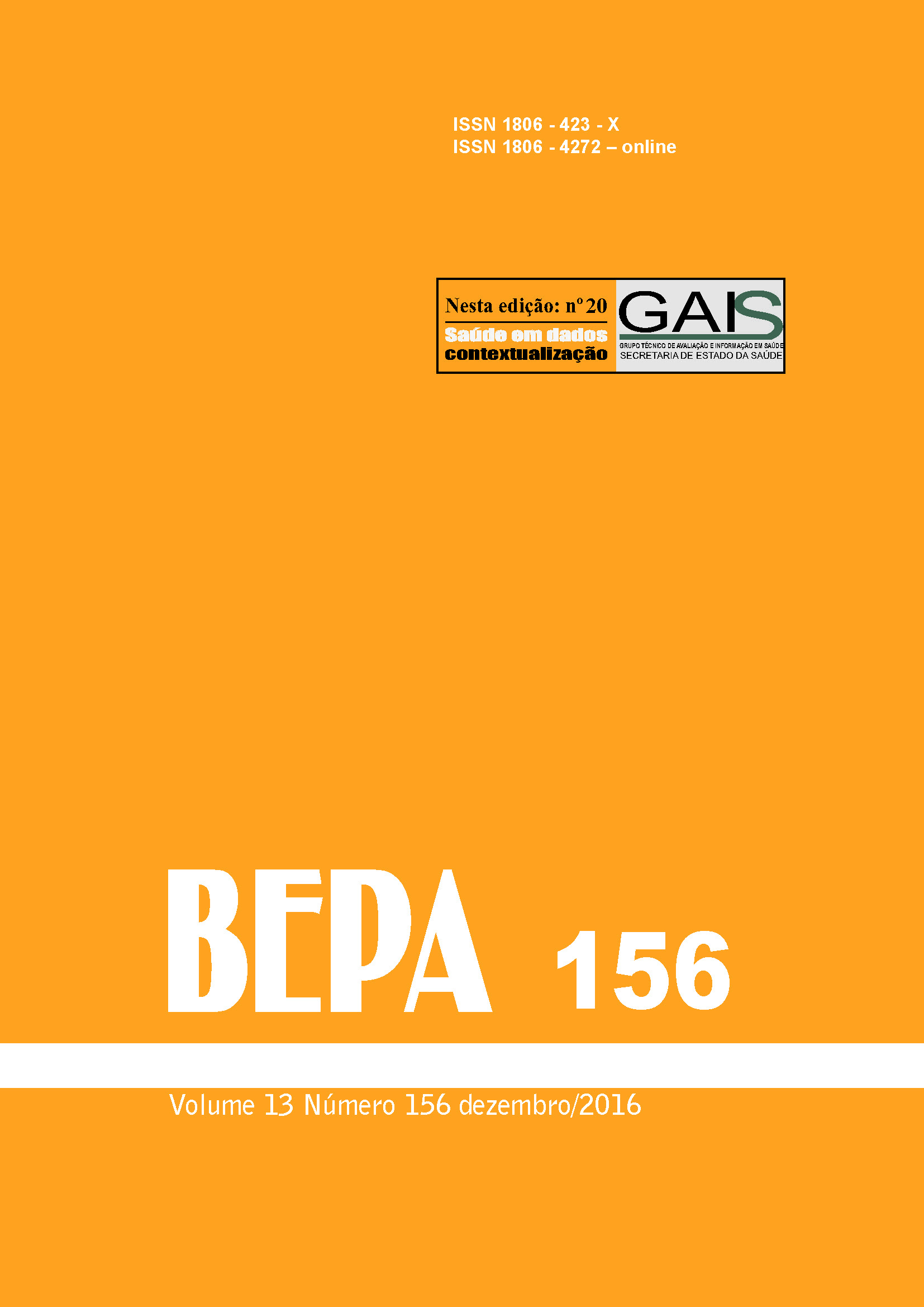Abstract
The present study identified the areas of highest recurrence and with the
highest probability of accidents caused by scorpions stings, correlating
these occurrences with the temperature and rainfall variations in Americana
city - São Paulo state, being the Tityus serrulatus the main cause of
accidents. By referring to the data collected from the investigation files of
the Information System of Diseases Notification (SINAN), from January
2009 to December 2013, an analysis of the spatial distribution of accidents
caused by scorpions was performed, generating maps by using ArcGIS
software 10.2.2. Information on the average temperature and rainfall in the
respective period was collected, being correlated with the occurrence of
968 accidents presenting an increasing linear trend in the respective years.
The applied geo-referencing process indicated seven urban areas of risk
for accidents (hotspots), and it proved to be an important predictive tool
for detecting the areas with the highest probability to the accidents caused
by scorpion stings.
References
Lourenço WR. Scorpion diversity
and distribution: past and present patterns.
In: Gopalakrishnakone P, Schwartz
EF, Possani LD, Rodríguez de la Vega
RC. Scorpion Venoms Toxinology.
Dordrecht: Springer Science+Business
Media; 2014. p.1-20.
Pardal PPO, Ishikawa EAY, Vieira JLF,
Coelho JS, Dórea RCC, Abati PAM et al.
Clinical aspects of envenomation caused
by Tityus obscurus (Gervais, 1843) in two
distinct regions of Pará state, Brazilian
Amazon basin: a prospective case series. J.
venom. anim. toxins incl. trop. dis. 2014; 20:3.
Brazil TK, Porto TJ. Os Escorpiões.
Salvador: EDUFBA; 2010.
Ministério da Saúde, Secretaria de
Vigilância em Saúde, Departamento de
Vigilância Epidemiológica. Manual de
controle de escorpiões. Brasília; 2009.
Scholte RGC, Caldeira RL, Simões
MCM, Stutz WH, Silva LL, Carvalho OS
et al. Inter and intrapopulational genetic
variability of Tityus serrulatus (Scorpiones,
Buthidae). Acta Trop. 2009; 112:97-100.
Chippaux JP. Emerging options for the
management of scorpion stings. Drug Design,
Development and Therapy. 2012; 6:165-73.
Albuquerque CMR, Santana-Neto PL,
Amorim MLP, Pires SCV. Pediatric
epidemiological aspects of scorpionism
and report on fatal cases from Tityus
stigmurus stings (Scorpiones: Buthidae)
in State of Pernambuco, Brazil. Rev. Soc.
Bras. Med. Trop. 2013; 46(4):484-489.
Torres JB, Marques MGB, Martini
RK, Borges CVA. Acidente por
Tityus serrulatus e suas implicações
epidemiológicas no Rio Grande do Sul.
Rev. saúde pública. 2002; 36(5):631-3.
Brites-Neto J, Brasil J. Estratégias de
controle do escorpionismo no município
de Americana, SP. BEPA – Bol.
Epidemiol. paul. 2012; 9(101):4-15.
Brasil J, Zumkeller S, Brites-Neto J. Perfil
Histórico do Escorpionismo em Americana.
Hygeia, Revista Brasileira de Geografia
Médica e da Saúde. 2013; 9(17):158-67.
Lucas SM, Goldoni PAM, Candido DM,
Knysak I. Butantan Institute: strategies
to obtain scorpions for the production
of antiscorpion serum. J. venom. anim.
toxins incl. trop. dis. 2010; 16(4):530-3.
Feliciano MAM, coord. Informativo
Sócio-Econômico do Município de
Americana-SP, n° 29 - ano base 2013.
Americana: SEPLAN – Unidade de
Estatística e Análise Socioeconômica; 2014.
Reckziegel GC, Pinto Jr VL. Scorpionism in
Brazil in the years 2000 to 2012. J. venom.
anim. toxins incl. trop. dis. 2014; 20:46.
Soares MRM, Azevedo CS, De Maria
M. Escorpionismo em Belo Horizonte,
MG: um estudo retrospectivo. Rev. Soc.
Bras. Med. Trop. 2002; 35(4):359-363.
Salomão MG, Albolea ABP, SobreiroGonçalves E, Almeida-Santos SM.
Animais peçonhentos no município de
Guarulhos, São Paulo, Brasil: incidência
de acidentes e circunstâncias com vistas
a sua prevenção. Publ. avulsas Inst. Pau
Bras. Hist. Nat. 2005; 8-9:77-83.
Borges MAFS. A vigilância epidemiológica
dos acidentes por escorpiões: uma
abordagem no campo da saúde
coletiva [dissertação]. São Paulo:
Universidade de São Paulo; 2004.
Barros RM, Pasquino JA, Peixoto LR,
Targino ITG, Sousa JA, Leite RS. Clinical
and epidemiological aspects of scorpion
stings in the northeast region of Brazil.
Ciênc. saúde coletiva. 2014; 19(4):1275-82.
Szilagyi-Zecchin VJ, Fernandes AL, Voltolini
JC, Castagna CL, Ferreira LY. Comparação
entre a abundância de Tityus serrulatus
(Lutz & Mello, 1922) e Tityus bahiensis
(Perty, 1833) (Scorpiones, Buthidae)
associados à gradientes da paisagem urbana.
Rev. Iber. Aracnol. 2013; 22:79-84.
Bücherl W. Acúleos que Matam.
São Paulo: Syntex; 1979.
Penedo GL, Schlindwein MN. Explosão
demográfica da espécie Tityus serrulatus,
(escorpião amarelo) na área urbana de
Araraquara e a sensível diminuição da
espécie Tityus bahiensis, (escorpião
marrom). Revista Uniara. 2004; 15:167-
(verificar o título da revista - http://
revistarebram.com/index.php/revistauniara)
Kotviski BM, Barbola IF. Aspectos
espaciais do escorpionismo em Ponta
Grossa, Paraná, Brasil. Cad. saúde
pública. 2013; 29(9):1843-58.
Warburg MR, Polis GA. Behavioral
Responses, Rhythms and Activity Patterns.
In: Polis GA. Biology of Scorpions. Stanford:
Stanford University Press; 1990. p.112-22.
Polis GA. Ecology. In: Polis GA.
Biology of Scorpions. Stanford: Stanford
University Press; 1990. p.123-44.
Szilagyi-Zecchin VJ, Fernandes AL,
Castagna CL, Voltolini JC. Abundance
of scorpions Tityus serrulatus and Tityus
bahiensis associated with climate in urban
area (Scorpiones, Buthidae). Indian Journal
of Arachnology. 2012; 1(2):15-23.
Cloudsley-Thompson JL. The scorpion.
Science Journal. 1975; 1(5):35-41.
Hoshino K, Moura ATV, De Paula
HMG. Selection of environmental
temperature by the yellow scorpion
Tityus serrulatus Lutz & Mello, 1922
(Scorpiones, Buthidae). J. venom. anim.
toxins incl. trop. dis. 2006; 12(1):60-6.
Brites-Neto J, Duarte KMR. Modeling
of spatial distribution for scorpions of
medical importance in the São Paulo
State, Brazil. Veterinary World.
; 8(7):823-30.
Bucaretchi F, Fernandes LCR, Fernandes
CB, Branco MM, Prado CC, Vieira RJ et al.
Clinical consequences of Tityus bahiensis
and Tityus serrulatus scorpion stings in
the region of Campinas, southeastern
Brazil. Toxicon. 2014; 89:17-25.
Ministério da Saúde, Secretaria de
Vigilância em Saúde, Departamento de
Vigilância das Doenças Transmissíveis.
Manual de vigilância, prevenção e
controle de zoonoses: normas técnicas
e operacionais. Brasília; 2016.
Ministério da Saúde, Secretaria de
Vigilância em Saúde, Coordenação
Geral de Desenvolvimento da
Epidemiologia em Serviços. Guia de
Vigilância em Saúde. Brasília; 2016.
Monma MTD, Brites-Neto J, Brasil
J. Avaliação dos efeitos de aplicação
da deltametrina microencapsulada
em áreas com acidentes por Tityus
serrulatus, em Americana, SP.
Vetores & Pragas. 2013; 33:20-4.

This work is licensed under a Creative Commons Attribution 4.0 International License.
Copyright (c) 2016 Maykon Vieira de Araújo, José Brites-Neto, Maria Eliana Carvalho Navega-Gonçalves
